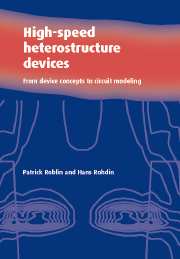Book contents
- Frontmatter
- Contents
- Preface
- Acknowledgements
- List of abbreviations
- Introduction
- 1 Heterostructure materials
- 2 Semiclassical theory of heterostructures
- 3 Quantum theory of heterostructures
- 4 Quantum heterostructure devices
- 5 Scattering processes in heterostructures
- 6 Scattering-assisted tunneling
- 7 Frequency response of quantum devices from DC to infrared
- 8 Charge control of the two-dimensional electron gas
- 9 High electric field transport
- 10 I – V model of the MODFET
- 11 Small- and large-signal AC models for the long-channel MODFET
- 12 Small- and large-signal AC models for the short-channel MODFET
- 13 DC and microwave electrothermal modeling of FETs
- 14 Analytical DC analysis of short-gate MODFETs
- 15 Small-signal AC analysis of the short-gate velocity-saturated MODFET
- 16 Gate resistance and the Schottky-barrier interface
- 17 MODFET high-frequency performance
- 18 Modeling high-performance HBTs
- 19 Practical high-frequency HBTs
- Index
13 - DC and microwave electrothermal modeling of FETs
Published online by Cambridge University Press: 06 July 2010
- Frontmatter
- Contents
- Preface
- Acknowledgements
- List of abbreviations
- Introduction
- 1 Heterostructure materials
- 2 Semiclassical theory of heterostructures
- 3 Quantum theory of heterostructures
- 4 Quantum heterostructure devices
- 5 Scattering processes in heterostructures
- 6 Scattering-assisted tunneling
- 7 Frequency response of quantum devices from DC to infrared
- 8 Charge control of the two-dimensional electron gas
- 9 High electric field transport
- 10 I – V model of the MODFET
- 11 Small- and large-signal AC models for the long-channel MODFET
- 12 Small- and large-signal AC models for the short-channel MODFET
- 13 DC and microwave electrothermal modeling of FETs
- 14 Analytical DC analysis of short-gate MODFETs
- 15 Small-signal AC analysis of the short-gate velocity-saturated MODFET
- 16 Gate resistance and the Schottky-barrier interface
- 17 MODFET high-frequency performance
- 18 Modeling high-performance HBTs
- 19 Practical high-frequency HBTs
- Index
Summary
The purpose of models is not to fit the data but to sharpen the questions.
11th R. A. Fisher Memorial Lectures, Royal Society, 20 April 1983, Samuel KarlinIntroduction
The design and simulation of microwave circuits with a circuit simulator requires the availability of fast and accurate models for all components in the circuit. From a design perspective, the reliability of the simulations of microwave circuits is usually limited by the device models that are available in the computer simulation tools used. Accurate and computationally efficient device models, that are easy to extract from measured data and can easily be incorporated into a circuit simulator, are therefore needed to improve and speed up the design of high-frequency circuits.
Although a model can come close, it can never exactly reproduce the performance of a device. Hence it is important to realize that the modeling effort may need to be tailored towards the kinds of circuits being simulated. This can be very important given the fact that not only accuracy, but also speed and convergence are important factors that need to be addressed.
In this chapter, we will present the methodology for the development of a universal field-effect transistor (FET) model for the DC, thermal and microwave modeling of three-terminal FET devices using some of the results derived in Chapter 11. Universal models are models that are applicable to a wide range of technologies. In this chapter we focus on the application of the universal microwave FET models to: (1) SOI (silicon on insulator) MOSFETs [1] for low-power RFIC integrating RF and digital circuitry on a single chip, and (2) LD MOSFETs [2] (laterally diffused MOS) for high-power, linear amplification.
- Type
- Chapter
- Information
- High-Speed Heterostructure DevicesFrom Device Concepts to Circuit Modeling, pp. 412 - 441Publisher: Cambridge University PressPrint publication year: 2002

